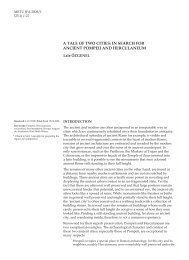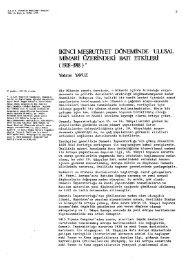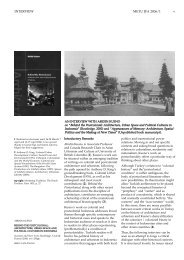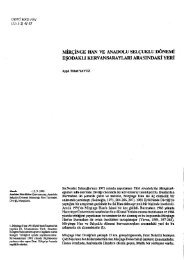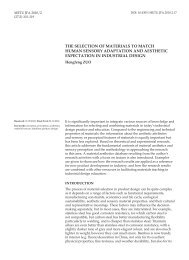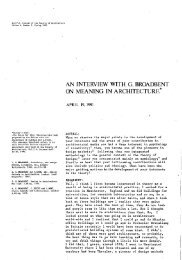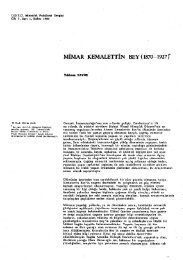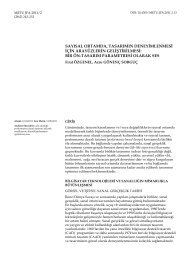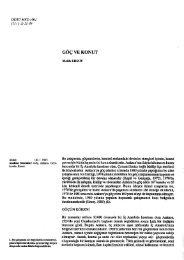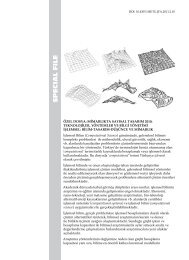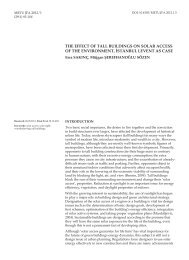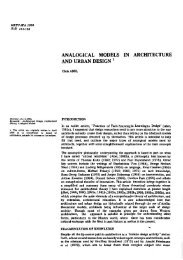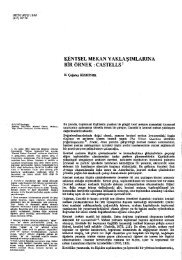kentsel mekanın üretiminde raslantısallık sorunu üzerine
kentsel mekanın üretiminde raslantısallık sorunu üzerine
kentsel mekanın üretiminde raslantısallık sorunu üzerine
Create successful ePaper yourself
Turn your PDF publications into a flip-book with our unique Google optimized e-Paper software.
KENTSEL MEKANIN ÜRETİMİNDE RASTLANTISALLIK ODTÜ MFD 1998 99<br />
Received : 7. 4. 1998<br />
Keywords: Theory of Space Formation,<br />
(Re)Production oi Space, Contingency,<br />
Uneven Development.<br />
ON THE PROBLEM OF CONTINGECY IN THE (RE)PRODUCTION OF<br />
URBAN SPACE<br />
ABSTRACT<br />
Urban space is socially produced. It is a product of a dialectical relationship<br />
between the 'space as a locus of affairs' and the 'focus of agents'. This social<br />
production of space is not realized autonomously. Space is structured, restructured,<br />
produced, reproduced and transformed by the conscious and unconscious<br />
efforts of the agents and by the mediation of all of these. The relationship<br />
between structure and agency is a dialectical one. These are (re)determined and<br />
(re)defined at different levels of the given social formation.<br />
Despite the conscious activities, mediations and interventions of the agents, the<br />
process of (re)production of urban space is to a certain extent open to contingencies.<br />
Urban space is (re)produced through complex relations of determination.<br />
Thus, any study on urban spatial patterns and state intervention into spatial<br />
development cannot be conceived by utilizing a mono-causal and uni-directional<br />
mode of reasoning.<br />
In capitalism, the process of creating, reproducing and using space is full of<br />
contradictions and tensions between capital and labor, between landed interests<br />
and capitalist interests, between landed interests and labor, etc. In social formations<br />
characterized by the articulation of non-capitalist modes of production with<br />
capitalist mode, we may add the contradictions and tensions pertinent to these<br />
articulated modes of productions and conflicts resulting from the confrontation<br />
of all of these. But urban space is not (re)produced as direct results of these<br />
contradictions, but on the basis of these contradictions.<br />
If a dialectical relationship between structure and the agents is not specified at<br />
all levels of analysis, whether it be global, regional or city level, the framework<br />
will necessarily lead to functionalism. In addition, a point of view which does not<br />
locate the sphere of class struggle, activities of the state, competition (organizational)<br />
and conflicts within the frame of analysis will fall into functionalism and<br />
in the final moment, will lead to capital-oriented explanations about urban<br />
spatial outcomes.<br />
The state's activity on space and its intervention into urban spatial (reproduction<br />
is structurally limited by the economic level, that is, ensemble of the<br />
articulations between productive forces and the relations of production and the<br />
mode of accumulation. The state itself as a structure is not a repetition of the<br />
economic level but a secondary moment of societal development.<br />
However, the production of space is open to certain contingencies. These emerge<br />
because of the complex determinations between structures and the agents in a<br />
dialectical manner. Selections among the structurally limited alternatives may<br />
produce different consequences. The contingency of outcomes emerges from the<br />
necessary articulation of the contradictions defining the determining structure<br />
and that of determined structures. This includes disparities, relations of<br />
reproduction and non-reproduction, functionalities and dysfunctionalities.<br />
There are some limits to this contingecy, that is, disparities between intended<br />
actions of the agents on space and the spatial outcomes. Here the vital question<br />
is which characteristics are reproduced in spatial reproduction.



